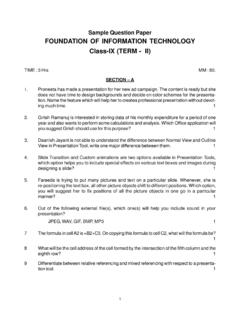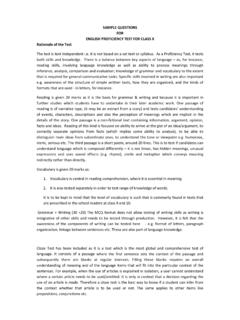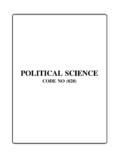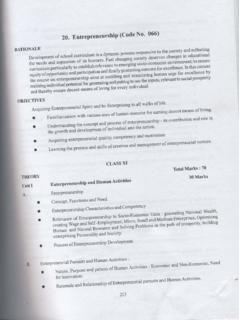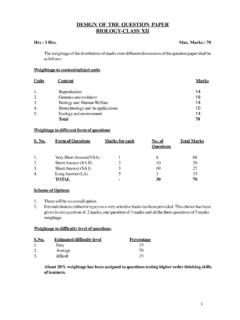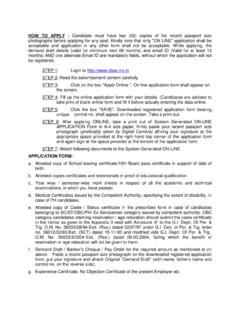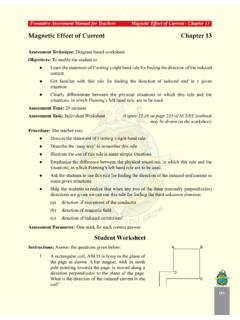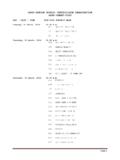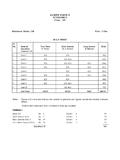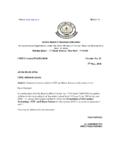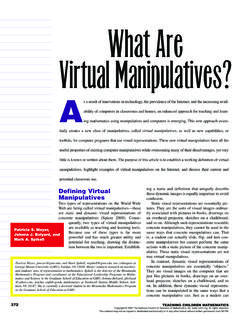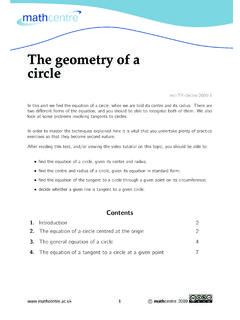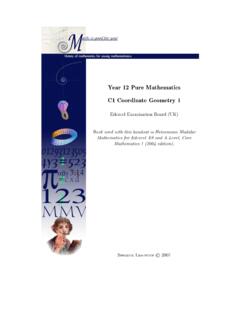Transcription of Guidelines for Mathematics Laboratory in Schools …
1 1 Guidelines forMathematics Laboratory in SchoolsClass XCentral Board of Secondary EducationPreet Vihar, Delhi IntroductionTaking into consideration the national aspirations and expectations reflected in therecommendations of the National Curriculum Framework developed by NCERT, the CentralBoard of Secondary Education had initiated a number of steps to make teaching and learningof Mathematics at school stage activity-based and experimentation oriented. In addition toissuing directions to its affiliated Schools to take necessary action in this regard, a documenton Mathematics Laboratory in Schools towards joyful learning was brought out bythe Board and made available to all the Schools . The document primarily aimed at sensitizingthe Schools and teachers to the concept of Mathematics Laboratory and creating awarenessamong Schools as to how the introduction of Mathematics Laboratory will help in enhancingteaching learning process in the subject from the very beginning of school education.
2 Thedocument also included a number of suggested hands-on the objective of strengthening the concept further, the Board brought out another document Guidelines for Mathematics Laboratory in Schools Class IX in the year 2005. Thedocument aimed at providing detailed Guidelines to Schools with regard to the general layout,physical infrastructure, material and human resources, etc for a Mathematics , the document included a list of hands-on activities and projects, detailed procedureto be followed for carrying out these activities and the scheme of evaluation. In the meantime,the Board had issued two circulars to all its Schools with regard to establishing MathematicsLaboratory and introduction of the scheme of internal assessment in the subject. Circularnumber 10 dated March 2, 2005 clarified that the internal assessment of 20% is to be givenon the basis of performance of an individual in activity work, project work and continuousassessment.
3 The Schools were also informed through the same circular that the scheme wouldbe effective for Class IX from the academic session 2005-2006 and for Class X from theacademic session starting April 2006 from March, 2007 About the present documentThe present document includes details of all Class X activities to be carried out by the studentsduring the full academic session. Description of a few sample projects has also been Class X is a terminal stage, great care has been taken to ensure that these activities aredirectly related to the syllabus, can be easily performed and do not require expensive equipmentor materials. A detailed evaluation scheme has also been given. A sincere attempt has beenmade to ensure that the students or teachers are not put to any kind of stress due to timeconstraint, curriculum load or any other difficulties in carrying out the proposed activity the sake of completeness and reinforcement of the concept, the present document reiteratesthe general features of a Mathematics Laboratory given in the earlier document for Class Mathematics is a Mathematics Laboratory ?
4 Mathematics Laboratory is a place where students can learn and explore mathematical conceptsand verify mathematical facts and theorems through a variety of activities using different activities may be carried out by the teacher or the students to explore, to learn, tostimulate interest and develop favourable attitude towards and purpose of Mathematics LaboratorySome of the ways in which a Mathematics Laboratory can contribute to the learning of thesubject are: It provides an opportunity to students to understand and internalize the basic mathematicalconcepts through concrete objects and situations. It enables the students to verify or discover several geometrical properties and factsusing models or by paper cutting and folding techniques. It helps the students to build interest and confidence in learning the subject. The Laboratory provides opportunity to exhibit the relatedness of mathematical conceptswith everyday life.
5 It provides greater scope for individual participation in the process of learning andbecoming autonomous learners. It provides scope for greater involvement of both the mind and the hand which facilatescognition. The Laboratory allows and encourages the students to think, discuss with each otherand the teacher and assimilate the concepts in a more effective manner. It enables the teacher to demonstrate, explain and reinforce abstract mathematical ideasby using concrete objects, models, charts, graphs, pictures, posters, and general layoutA suggested design and general layout of Laboratory which can accommodate about 32 studentsat a time is given here. The design is only a suggestion. The Schools may change the designand general layout to suit their own infrastructure and materialsIt is envisaged that every school will have a Mathematics Laboratory with a general designand layout as indicated with suitable change, if desired, to meet its own requirements.
6 Theminimum materials required to be kept in the Laboratory may include furniture, all essentialequipment, raw materials and other necessary things to carry out the activities included in thedocument effectively. The quantity of different materials may vary from one school to anotherdepending upon the size of the ResourcesIt is desirable that a person with minimum qualification of graduation (with Mathematics as oneof the subjects) and professional qualification of Bachelor in Education be made incharge ofthe Mathematics Laboratory . He/she is expected to have special skills and interest to carryout practical work in the subject. The concerned Mathematics teacher will accompany theclass to the Laboratory and the two will jointly conduct the desired activities. A laboratory5attendant or Laboratory assistant with suitable qualification and desired knowledge in the subjectcan be an added Allocation for activitiesIt is desirable that about 15% - 20% of the total available time for Mathematics be devoted toactivities.
7 Proper allocation of periods for Laboratory activities may be made in the time total available time may be divided judiciously between theory classes and Scheme of Evaluation (Class X) assessmentIt is envisaged that 20% weightage will be given to the internal assessment in the subject. Thefollowing weightages have been assigned to Board s theory examination and school basedinternal assessment for Class X examination. The scheme will be effective from March, 2007examination Examination:80 marksInternal Assessment:20 marksThese weightages have also been reflected in the Board s document Secondary SchoolCurriculum, 2007, volume assessment of 20 marks, based on school -based examination, will have the followingbreak-up:Year-end assessment of activities:10 marksAssessment of project work:05 marksContinuous assessment:05 of Activity WorkThe year-end assessment of activities and project work will be done during an organizedsession of an hour and a half with intimation to the Board.
8 The following parameters may bekept in mind for the same:a)The proposed internal examination may be organized in the month of February as perthe convenience of the )Every student may be asked to perform two given activities during the allotted care may be taken in choosing these two activities to ensure that the studentsare not put to any kind of stress due to time )The students may be divided into small groups of 20-25 as per the convenience of )The assessment may be carried out by a team of two Mathematics teachers includingthe teacher teaching the particular )The break-up of 10 marks for assessment of a single activity could be as under: Statement of the objective of activity:01 mark Design or approach to the activity:02 marks Actual conduct of the activity:03 marks Description/explanation of the procedure:03 marks Result and conclusion:01 markThe marks for assessment of two activities (10+10) may be added and then reduced to beout of student may be asked to complete the activities given in this document during theacademic year and maintain a proper activity record of this Schools would keep a record of the activity notebook and project work of the students work as well as answer scripts of this examination for verification by the Board, whenevernecessary, for a period of six of project workEvery student will be asked to do at least one project, based on the concepts learnt in theclassroom.
9 The project should be preferably carried out individually and not in a group. Theproject may not be mere repetition or extension of the Laboratory activities, but should aim atextension of learning to real life situations. Besides, it should also be somewhat open-endedand innovative. The project can be carried out beyond the school working hours. Somesample projects are given in the document but these are only illustrative in nature. The teachermay encourage the students to take up new projects. The weightage of five marks for projectwork could be further split up as underIdentification and statement of the project:01 markDesign of the project:01 markProcedure/processes adopted:01 markWrite-up of the project:01 markInterpretation of result:01 AssessmentThe procedure given below may be followed for awarding marks for continuous assessmentin Class )Reduce the marks of Class IX annual examination to be out of ten )Reduce the marks of Class X first terminal examination to be out of ten )Add the marks of (a) and (b) above and get the achievement of the student out oftwenty )Reduce the total in (c) above to the achievement out of five marksThe marks (out of 5) may be added to the score of year-end assessment of activities andproject work (10 + 5) to get the total score out of 20 Activities1.
10 To obtain the conditions for consistency of a system of linear equations in twovariables by graphical To verify that the given sequence is an arithmetic progression by paper cutting andpasting To verify that the sum of first n natural numbers is n(n + 1) / 2, that is n = n (n + 1) / 2, by graphical To verify the Basic Proportionality Theorem using parallel line board and To verify the Pythagoras Theorem by the method of paper folding, cutting andpasting6. To verify that the angle subtended by an arc at the centre of a circle is twice theangle subtended by the same arc at any other point on the remaining part of thecircle, using the method of paper cutting, pasting and To verify that the angles in the same segment of a circle are equal, using the methodof paper cutting, pasting and To verify, using the method of paper cutting, pasting and folding thata.
